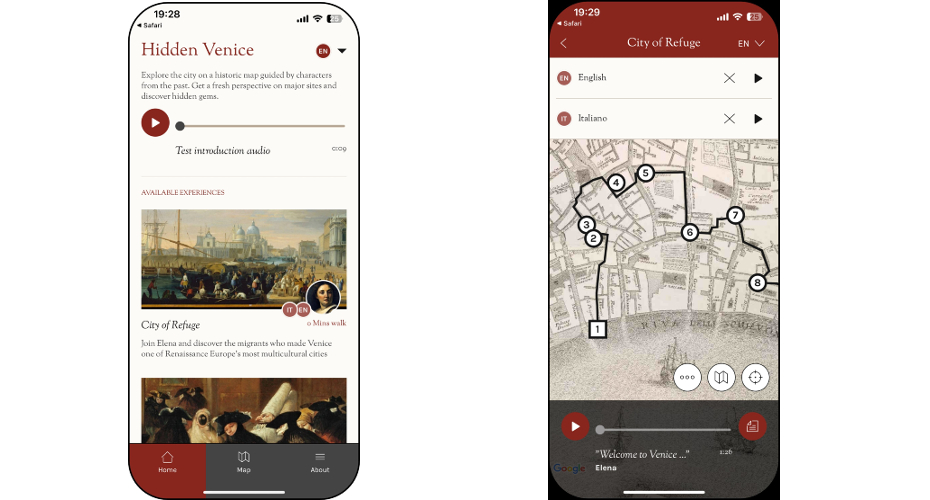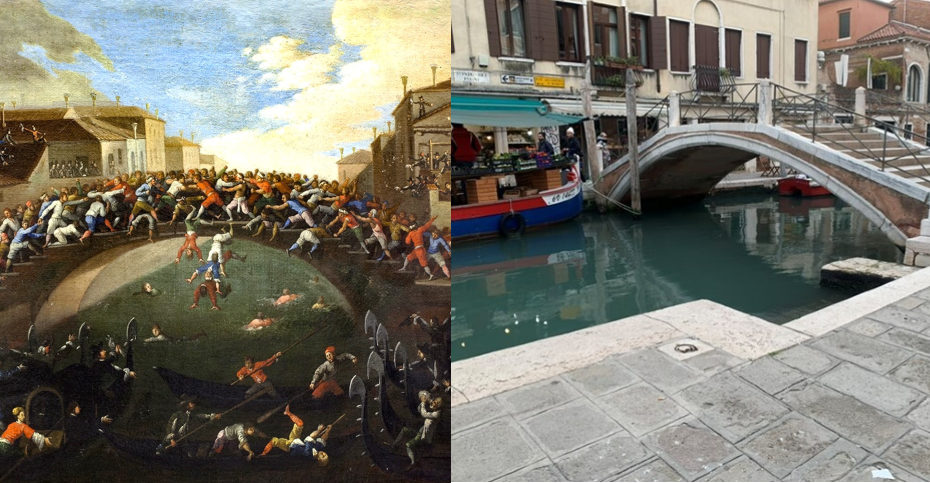Immersive app provides trio of first-person perspectives of historic Venice

Historic tales of vice, migration and multiculturalism, and ritualistic fighting on the bridges have been brought to life in an immersive app for the City of Venice.
Hidden Venice will offer users three separate first-person stories drawn from key moments across the 16th-to-18th centuries, and each grounded in research from experts in the field.
Through Venice Unmasked: 1730; Boats, Bridges and Battles: 1639; and City of Refuge: 1572, users will experience the lived history of their narrator and guide, visiting iconic piazzas, bridges and churches as well as many significant locations off the classic tourist trail.
The smartphone app – which can be downloaded for free – is the latest in the acclaimed HistoryCity series, led by historians in the Department of Languages, Cultures and Visual Studies at the University of Exeter. For this project, they have collaborated closely with counterparts at Ca’ Foscari University of Venice, and the Venice Centre for Digital and Public Humanities.
“Venice may be a hypertouristed city, but it can still be hard to get into the history that’s all around you,” says Dr David Rosenthal, the series’ trail director. “HistoryCity’s first-person or living history approach gives you a sense of having one foot in the past, one in the present. It shows how people experienced the places and objects that were part of their lives, and we tell stories that unpack the worlds that gave these places meaning.
“In Hidden Venice, we’ve also pushed the way we do storytelling further, with a true crime trail, ‘Venice Unmasked’, where the user is invited to join a ‘vice squad’ investigation in 1730.”
Written by Dr Celeste McNamara, of Dublin City University, Venice Unmasked features Capitano Zuanne Biancafior, a genuine historical figure who was part of the city’s Executors against Blasphemy. The task of this civic body was to defend Venice’s image and moral reputation from an increasingly libertine culture of gambling, sex and carnival excess.
The trail presents a real case, its locations and cast of characters, as Biancafior hunts a predator who has been sexually harassing women in the city’s churches.
Dr McNamara said: “With the ‘Venice Unmasked’ trail what I wanted to do was bring to the surface the deep contradictions and tensions within Venetian society in this era, and show how the government handled the apparently timeless problem of predatory men who seemed to believe they could act with impunity.”
The second trail, Boats, Bridges and Battles: 1639, leads users on a tour via foot and gondola towards the Ponte dei Pugni – the Bridge of the Fists. This was one of many sites that hosted ‘battles’ – ritualistic brawls between rival neighbourhoods and trades – that drew in spectators and patrons in their 17th century heyday.

Written by Fabrizio Nevola, Professor in Art History and Visual Culture at Exeter, the trail follows apprentice boatbuilder ‘Sebastiano’ across the Grand Canal and through the Dorsoduro district as he makes his way to the bridge.
The third trail – City of Refuge – has been created by Associate Professor Dr Rosa Salzberg of the University of Trento, and follows Greek migrant Elena on a journey from the port near Piazza San Marco to the shipyards of the Arsenale, best known today as the venue for Venice’s art Biennale.
“The City of Refuge trail highlights how Venice has always been shaped by waves of migration,” says Dr Salzberg. “These migrants could be refugees like our app character Elena, who fled from Greece due to Ottoman advances, but also merchants, sailors and artisans looking for work in the urban economy. It takes you to the places these new arrivals carved out for themselves and that helped many to integrate into the local community. I wanted to show how issues that remain important and debated today – migration, integration, multiculturalism – played out in the past.”
The app trails take place on an interactive historic map, created by Ludovico Ughi in 1729. Ughi’s groundbreaking topographical work was the first to use field surveys and established the template for all others to follow in depicting Venice.
“Venice is a city where people invariably use the map on their phone to find their way around – so Hidden Venice is ideally placed to offer people alternative routes through the city using that same familiar device,” says Professor Nevola. “Instead of avoiding canals and crossing bridges using the Google map, the spectacular eighteenth-century map by Ludovico Ughi provides a fun and immersive way of experiencing the city through a historical lens.”
HistoryCity is a publicly funded project. Apps include Hidden: Valencia, Florence, Exeter, Copenhagen, Hamburg, Deventer, Trento, Tours, and Landshut. Upcoming releases this year include a new trail for Hidden Trento, set in 1943, that addresses the Second World War and Fascism in Italy. All apps are free from the App Store and Google Play.



